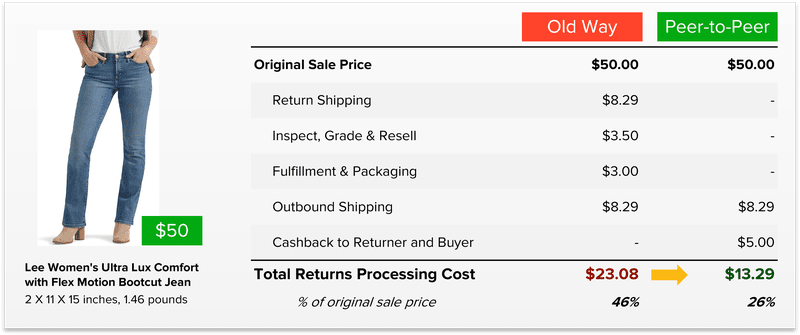Top Ecommerce Returns Best Practices: Strategies for Efficiency & Customer Satisfaction

Last updated on April 16, 2025

In this article
 15 minutes
15 minutes
- Key Takeaways
- Understanding the Importance of Ecommerce Returns
- Crafting a Customer-Friendly Return Policy
- Offering Free Return Shipping: Pros and Cons
- Streamlining the Returns Process
- Reducing Return Rates with Accurate Product Listings
- Handling In-Store Returns for Online Purchases
- Leveraging Returns Data for Business Insights
- Enhancing Customer Communication During the Returns Process
- Preventing Return Fraud
- Sustainable Practices in Ecommerce Returns
- Summary
- Frequently Asked Questions
Managing ecommerce returns effectively is crucial for customer satisfaction and business efficiency. This article dives into the ecommerce returns best practices for handling returns, from crafting a customer-friendly return policy to leveraging returns data for business insights. Whether you’re looking to streamline the return process or reduce return rates, these strategies will help you enhance the customer experience and improve your bottom line.
Key Takeaways
- Efficient return management is vital for customer satisfaction and retention in ecommerce, with 80% of customers avoiding retailers with poor return experiences.
- A clear, customer-friendly return policy boosts trust and loyalty, while highlighting this policy on your website can significantly enhance sales.
- Leveraging returns data and incorporating technology, like AR for product visualization, can reduce return rates and improve the overall customer experience.
Understanding the Importance of Ecommerce Returns
Ecommerce returns are more than just a logistical challenge; they are a critical component of customer satisfaction and retention for any ecommerce business. In a highly competitive market, online retailers must prioritize efficient ecommerce return management to stay ahead. A staggering 80% of customers will not shop again with a retailer that offers a poor return experience. This statistic alone underscores the importance of having a seamless and customer-friendly returns process, especially considering the average ecommerce return rate.
Returns also play a significant role in customer retention. Shoppers who have a positive return experience are more likely to make future purchases, turning potential one-time buyers into loyal customers. A transparent and flexible return policy builds trust, giving customers confidence in their purchasing decision and reducing the perceived risk of buying online, ultimately enhancing the post-purchase experience.
Moreover, managing returns effectively can create a competitive advantage and increase profitability. Ecommerce returns, if handled well, can enhance customer satisfaction and build long-term loyalty. Transparent return policies not only manage customer expectations but also increase overall satisfaction, which can significantly impact a business’s bottom line.
In summary, understanding the importance of ecommerce returns is the first step in creating a return strategy that enhances customer experience, builds trust, and drives repeat business. Prioritizing returns management allows ecommerce businesses to transform a potential challenge into a powerful tool for customer retention and business growth.
Crafting a Customer-Friendly Return Policy
A well-crafted, customer-friendly return policy is the cornerstone of an effective ecommerce returns strategy. It not only enhances customer satisfaction but also fosters trust and loyalty. Transparency is key; customers need to know exactly what to expect when they decide to return a product. Having a clear, visible, and transparent ecommerce returns policy gives customers peace of mind and can significantly influence their purchasing decisions.
A comprehensive return policy should be easy to understand and free of legal jargon. It should clearly outline the return process in second-grade language, including acceptable reasons for returns, the time frame within which returns are accepted, and the available options for refunds or exchanges. Including contact information for customer support ensures that customers can easily reach out with any questions or concerns.
A customer-friendly return policy removes ambiguities that might result in customer dissatisfaction or fraudulent returns. Such a policy not only protects the business but also strengthens customer relationships, leading to increased satisfaction and loyalty.
Key Elements of an Effective Return Policy
Crafting an effective return policy involves several key elements that ensure clarity. First and foremost, the policy should be straightforward and free of complex legal terms, making it easy for customers to understand. Transparency and clarity are key; the return policy must be specific and consistent across all customer touchpoints.
Consideration of the return window length is essential. While most ecommerce retailers offer a 30-day return window, some businesses extend this period to 60, 90 days, or even a year to build trust and loyalty. However, it’s important to balance this flexibility with the ability to manage inventory efficiently and address individual customer situations as needed.
Additionally, encouraging proof of purchase for returns helps identify legitimate transactions and discourages return fraud. A well-defined return policy not only enhances customer satisfaction but also aids in managing returns effectively, ultimately contributing to customer retention and business growth.
Highlighting Your Return Policy on Your Ecommerce Website
Making the return policy easily accessible on your ecommerce website can significantly boost customer confidence and potentially increase sales. Approximately two-thirds of consumers check an ecommerce retailer’s return page before making a purchase. Highlighting your return policy on multiple pages, including product pages, the footer, and the checkout screens, ensures maximum visibility and accessibility.
One client experienced a 20% lift in sales after prominently featuring their offer for free shipping along with their returns policy. Making the return policy easily accessible builds customer trust and encourages purchases, as customers feel assured they can return products hassle-free if needed.
Offering Free Return Shipping: Pros and Cons
Offering free return shipping is a powerful way to enhance customer satisfaction and encourage repeat purchases. A significant number of consumers view free returns as a critical factor influencing their shopping choices, making it a competitive advantage for ecommerce businesses. Free return policies can lead to increased sales, as customers are more likely to purchase when they know they can return items at no cost.
Despite its benefits, free return shipping presents challenges. Costs like shipping labels, restocking, and potential damages can impact profitability. Despite these costs, the benefits of offering free returns, such as higher conversion rates and larger overall basket sizes, often outweigh the drawbacks.
Balancing the costs and benefits of free return shipping is crucial. While it can enhance customer satisfaction and provide a competitive edge, businesses must ensure that their profit margins can handle the associated costs. Carefully evaluating when and how to offer free return shipping helps ecommerce businesses balance customer satisfaction and profitability.
When to Offer Free Return Shipping
Offering free return shipping can significantly boost sales, especially for high-risk products where customers require assurance. Three-quarters of shoppers consider free returns essential in their purchasing decisions. Providing free returns enhances customer satisfaction and encourages repeat purchases, making it a valuable strategy for ecommerce businesses, including free ecommerce returns.
However, it’s important to communicate free return shipping policies clearly on product listings, FAQ pages, and the shipping policy page to ensure customers are aware of this benefit. This reassurance can encourage customers to commit to online purchases, knowing they can return items at no additional cost if needed. And if it’s not communicated effectively, it gets lost in the weeds.
Alternatives to Free Return Shipping
While free return shipping is beneficial, it may not always be feasible for every business. Alternatives such as offering store credit instead of refunds can help manage return costs while maintaining customer satisfaction. Charging customers for returns may be appropriate for larger items that require specialized collection services.
Balancing the costs of returns with customer expectations is crucial for sustaining both profitability and satisfaction. By exploring alternatives to free return shipping, ecommerce businesses can find a strategy that works best for their unique needs and customer base.
Streamlining the Returns Process
Streamlining the returns process is essential for enhancing customer satisfaction and loyalty. Implementing clear steps for managing returns ensures a smooth and efficient process, reducing customer frustration. Automation in the return process, such as using reverse logistics, can provide a seamless experience for customers and minimize costs.
Simplifying the return process is crucial for enhancing customer satisfaction and loyalty. Offering hassle-free returns reduces customer worry about potential return costs. A clear return policy can significantly reduce costs associated with returns by promoting customer confidence and reducing the number of unnecessary returns.
Investing in technology, like scanners for processing returns, can lead to significant labor savings and improve overall efficiency. By streamlining the returns process, ecommerce businesses can reduce costs and improve profitability.
Automating Return Labels and Shipping
Automating return labels and shipping is a game-changer for managing returns efficiently. Automation minimizes human errors and saves processing time for returns, leading to a smoother experience for both customers and businesses. Using a combination of scannable, pre-printed, and printable return labels can accommodate various customer needs and improve efficiency.
Integrations with platforms like Loop and Shopify can significantly enhance return label handling, making the process more seamless for ecommerce brands. Informing customers about the return shipping carrier fosters trust, especially if they are familiar with the carrier.
Implementing Reverse Logistics
Implementing reverse logistics is crucial for managing returns effectively. Establishing a returns management strategy that focuses on the reverse supply chain can mitigate the environmental repercussions of returns and improve overall efficiency. Effective reverse logistics can streamline the returns process and reduce the overall time taken to process returns, enhancing customer satisfaction.
Third-party logistics providers can help manage returns and inventory without the need for in-house resources, making the process more efficient and cost-effective. A robust reverse logistics system enhances customer satisfaction and operational efficiency.
Reducing Return Rates with Accurate Product Listings
Accurate product listings are essential for reducing return rates and increasing customer satisfaction. Inaccurate or missing product information significantly increases the likelihood of product returns. Providing complete product details such as materials and dimensions directly on product pages can significantly lower return rates by setting proper customer expectations before purchase.
Detailed and visible product labels help customers make informed decisions and reduce the likelihood of returns. Frequently revising product information ensures customers are aware of any changes, reducing the chance of returns due to outdated details.
Accurate and detailed product listings help reduce return rates and improve customer satisfaction.
Utilizing 3D/AR Technology
Utilizing 3D and augmented reality (AR) technology can significantly enhance the online shopping experience. Augmented reality allows customers to visualize products in their own space, leading to better purchasing decisions and reducing the likelihood of returns. This interactive shopping experience can help customers feel more confident in their purchases, ultimately reducing return rates.
Incorporating 3D/AR technology into product listings offers a more immersive and accurate representation, boosting customer satisfaction and reducing returns.
Regularly Updating Product Pages
Regularly updating product pages is important for maintaining transparency and trust with customers. Accurate product descriptions, images, and size guides are essential to reduce return rates, as they help set proper customer expectations before purchase. Frequent updates ensure that customers always have access to the latest information about products, which can significantly lower the chances of returns due to outdated or incorrect details.
Utilizing advanced technologies such as 3D modeling and augmented reality allows customers to visualize products better, leading to more informed purchasing decisions. Maintaining engaging and up-to-date content on product pages enhances the shopping experience, potentially increasing customer loyalty and repeat business.
Handling In-Store Returns for Online Purchases
Handling in-store returns for online purchases offers a convenient option for customers and can enhance overall satisfaction. The buy online, return in-store (BORIS) strategy allows customers to return items purchased online to a physical store, reducing return shipping costs and providing instant resolution. This approach not only improves customer satisfaction but also encourages in-store engagement and potential additional purchases.
Allowing in-store returns can also help reduce return rates by offering customers an easy and convenient return option. This flexibility can enhance the overall shopping experience and foster loyalty among customers who appreciate the convenience of returning items to brick and mortar stores.
Integrating in-store returns with online purchases and online returns provides a seamless return experience, catering to customer preferences and enhancing satisfaction.
Training Staff for Efficient Returns
Properly training staff to handle returns efficiently is essential for improving customer interactions and satisfaction. Staff should be trained to empathize with customers during returns, creating a more positive experience. Providing clear knowledge of the return policy helps ensure consistent customer service, which is crucial for maintaining customer trust and satisfaction.
Offering various contact options, including live chat and email, can meet customer preferences and enhance their return experience. Effective staff training ensures returns are handled efficiently, improving customer interactions and satisfaction, supported by a customer support team.
Encouraging Exchanges Over Refunds
Encouraging exchanges over refunds can be a beneficial strategy for ecommerce businesses. Promoting exchanges instead of refunds can help businesses retain 50% of revenue that would otherwise be lost in refunds. Offering incentives for exchanges, such as discounts on future purchases, can significantly boost profitability and customer satisfaction which can lead to higher customer retention rates and potentially increase overall sales. Promoting and offering exchanges improves the bottom line for each loyal customer.
Leveraging Returns Data for Business Insights
Leveraging returns data is crucial for gaining valuable insights and improving operations. Analyzing returns data can help identify trends and understand customer behavior, which can significantly improve product offerings and marketing strategies. Certain product categories, like apparel, tend to have higher return rates, and understanding these trends can help businesses address common issues.
Returns data can reveal widespread quality issues or sizing discrepancies that need to be addressed. Management reports on returns data provide valuable information such as return reasons, costs, and details about re-sellable items, helping businesses make informed decisions.
Leveraging returns data helps drive purchase velocity and increase order value.
Identifying Common Return Reasons
Identifying common return reasons is essential for reducing return rates and improving customer satisfaction. Analyzing returns data can reveal common quality defects and sizing problems that lead to higher return rates. Frequent reasons for returns in ecommerce include incorrect sizing, substantial product defects, and discrepancies between customer expectations and product delivery.
Addressing these common return issues not only aids in reducing return rates but also enhances overall customer satisfaction with the ecommerce experience. Understanding and addressing the reasons behind returns helps improve products and customer service, leading to increased satisfaction and loyalty.
Adjusting Inventory Management Based on Returns
Adjusting inventory management processes based on returns data helps to optimize stock levels and reduce costs. Monitoring returns can inform decisions about which products to restock or discontinue, preventing overstocking of frequently returned items. Effective inventory management requires real-time updates to reflect return transactions accurately, ensuring that inventory levels are always up-to-date.
Establishing refund thresholds can help monitor and control the return process and process refunds for high-value products, reducing the risk of fraud and ensuring that inventory is managed efficiently.
Adjusting inventory practices based on return trends enhances operations and profitability.
Enhancing Customer Communication During the Returns Process
Clear and effective communication during the returns process is essential for maintaining customer trust and satisfaction. Communicating clear return policies can significantly influence customer purchase decisions and enhance their overall experience. Maintaining good communication with returning customers is vital to avoid losing customers for future shopping opportunities.
Providing real-time updates on the status of returns reassures customers about your transparency. Customers should be kept informed about the status of their return, and politeness and timeliness are crucial when communicating with customers about returns.
Enhancing communication during the returns process builds customers’ trust and improves customer satisfaction.
Providing Real-Time Updates
Providing real-time updates on return statuses can significantly enhance customer satisfaction. Using automated tools to send updates ensures that customers are always informed about the status of their return, reducing anxiety and enhancing the overall experience. Automated communication can enhance the returns process by sending automated emails and integrating with chatbots for status updates.
Customers can track their returns through a returns portal, providing transparency and building trust. Using shipment tracking can also deter potential fraudulent claims about non-delivery by providing proof of delivery.
Providing real-time updates enhances customer satisfaction and reduces return-related issues.
Offering Multiple Communication Channels
Offering multiple communication channels for customer returns enhances the overall experience and meets customer preferences. Providing various means to return purchases seamlessly improves customer experience and satisfaction. Chatbot functions for customer service inquiries can be integrated with automated returns software, offering a convenient and efficient way for customers to get support.
Informing customers about the shipping carrier used for returns also helps build trust and provides transparency. Offering multiple communication channels ensures customers receive the support they need throughout the return process, enhancing satisfaction and loyalty.
Preventing Return Fraud
Preventing return fraud is essential for maintaining profitability and operational efficiency in ecommerce. Tracking customer return frequency helps businesses identify patterns that may indicate fraudulent behavior. Employing serial number tracking helps to mitigate fraudulent returns effectively.
Ecommerce businesses can prevent return fraud by flagging repeat returners and limiting return windows for fast-moving products. Offering store credit instead of cash refunds can deter return fraud by providing an immediate value to the customer without a financial loss.
Tools like Shopify Flow and Cahoot can assist retailers in managing return fraud more effectively by automating elements of the returns process.
Implementing Return Approvals for High-Value Items
Implementing return approvals for high-value items can help prevent fraud and protect business profitability. Requiring pre-approval for returning expensive items can deter potential abuse and ensure that returns are legitimate. Boundaries help avoid foul play and abuse of the system, and they build customer trust in the brand.
A reasonable return window, clarity on non-returnable items, charging shipping fees, limiting returns based on payment methods, and optional restocking fees can help prevent abuse and ensure a fair return process. Implementing these strategies helps protect ecommerce businesses from return fraud and maintain customer trust.
Monitoring Repeat Returners
Monitoring repeat returners is essential for maintaining the integrity of the return process and preventing fraud. Regularly tracking customers who frequently return items can help identify and address potential fraudulent behaviors. Identifying customers who frequently return items can assist in flagging possible fraudulent behavior and taking necessary actions to mitigate risks.
Taking necessary actions based on tracking results can help mitigate risks associated with return fraud and ensure that the return process remains fair and efficient.
Monitoring repeat customers and returners protects ecommerce businesses from fraudulent returns and maintains customer loyalty.
Sustainable Practices in Ecommerce Returns
Implementing sustainable practices in ecommerce returns can significantly reduce environmental impact and promote corporate responsibility. Encouraging customers to print their own return labels online as needed can help decrease the overall paper waste associated with returns. The environmental impacts of traditional return processes contribute to global carbon emissions due to transport, highlighting the need for more sustainable practices.
Retailers can enhance sustainability by implementing programs that facilitate the resale or donation of returned products to support charitable causes. Donating returned items to charities not only reduces waste but also benefits the community and promotes corporate social responsibility.
Adopting sustainable best practices in ecommerce returns reduces the environmental footprint and enhances brand image.
Encouraging Online Label Printing
Encouraging customers to print return labels at home can significantly cut down on paper waste associated with traditional label printing methods. Online label printing reduces the need for pre-printed labels, which often go unused and contribute to waste. Promoting online label printing reduces environmental impact and supports sustainability initiatives.
This practice not only benefits the environment but also enhances customer convenience, as they can easily print labels at home without waiting for pre-printed labels to arrive. Encouraging online label printing is a simple yet effective way for ecommerce businesses to adopt more sustainable practices.
Reselling or Donating Returned Items
Reselling or donating returned items helps reduce waste by extending the life of products that are still usable. Sustainable practices in ecommerce returns, such as encouraging online label printing and efficient reverse logistics, support the reselling and donating process. Integrating reselling and donating options into returns processes can enhance brand image, boost customer loyalty, and cater to environmentally-conscious consumers.
Implementing resale strategies can help keep returned products out of landfills and generate revenue, while donating items to charities benefits the community and promotes corporate social responsibility. By adopting these sustainable practices, ecommerce businesses can reduce their environmental impact and support a more sustainable future.
Summary
In summary, managing ecommerce returns effectively is crucial for enhancing customer satisfaction and business profitability. From crafting a customer-friendly return policy and offering free return shipping to leveraging returns data for business insights and implementing sustainable practices, there are numerous strategies that ecommerce businesses can adopt to improve their return processes. By prioritizing returns management, businesses can build trust, drive repeat purchases, and create a competitive advantage in the market.
As we move towards a more sustainable future, implementing eco-friendly practices in ecommerce returns is not only beneficial for the environment but also enhances brand image and customer loyalty. By following the best practices discussed in this blog post, ecommerce businesses can turn returns from a challenge into an opportunity for growth and success. Embrace these strategies and watch your business thrive in 2025.
Frequently Asked Questions
How can a clear return policy impact customer satisfaction?
A clear return policy boosts customer satisfaction by building trust and setting the right expectations, making shoppers feel more confident in their purchases. It’s a smart move for any business!
What are the benefits of offering free return shipping?
Offering free return shipping boosts customer satisfaction and encourages them to shop with you again, which can really set you apart from the competition. It’s a win-win!
How can returns data provide business insights?
Returns data can give you a clear picture of why products are coming back, like quality or sizing problems, so you can tweak your offerings and marketing to better meet customer needs. It’s a smart way to turn setbacks into opportunities for improvement!
Why is it important to monitor repeat returners?
It’s crucial to keep an eye on repeat returners to spot any potential fraud and ensure the return process stays fair. This way, you protect your business and maintain customer trust.
What are some sustainable practices in ecommerce returns?
To make ecommerce returns more sustainable, try promoting online label printing, reselling or donating returns, and streamlining reverse logistics. These steps can really help cut down on waste!

Up to 64% Lower Returns Processing Cost


